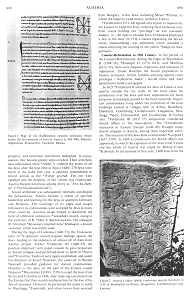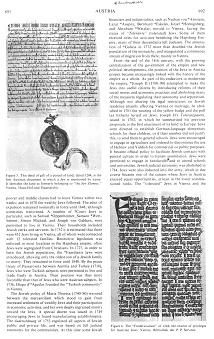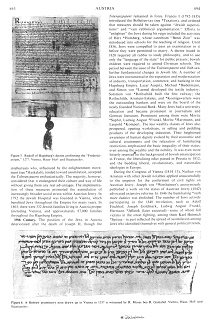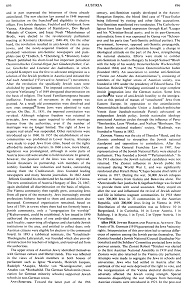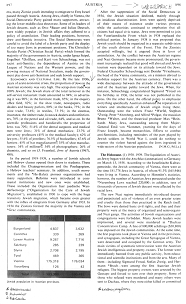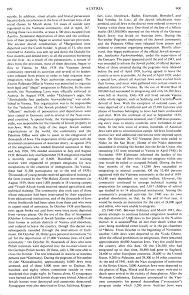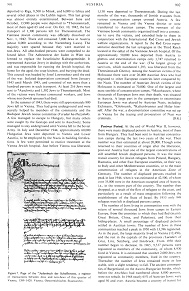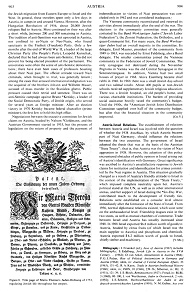[since 1918: minority rights - restrictions in schools
and restrictions concerning the right to vote -
Zionism - Jewish parties - Jewish prominents]
<After 1918.
JEWISH RIGHTS AND POLITICAL ACTIVITY.
The Treaty of St. Germain (1919) guaranteed the Jews
*minority rights. Interpretation of this provision led
to serious differences of opinion among the Jewish
parties themselves. The Zionists founded a Jewish
National Council (Juedischer Nationalrat) and the
Soldiers' Committee protected Jews in the postwar
unrests. The Zionist Robert *Stricker was elected to the
first Austrian National Assembly in 1919 and three
Zionists were also returned to the Vienna city
parliament.
Attempts were made to segregate the Jews in schools and
universities. Jews who had settled in Austria after the
outbreak of the war were deprived of the right to vote,
and the reorganization of the Vienna electoral districts
also adversely affected the Jewish voting strength.
Special measures disqualifying the war refugees from
becoming Austrian citizens were introduced in 1921.
In the post-war (col. 896)
era, many Zionist youth intending to emigrate to Erez
Israel passed through Austria. Among Jews, chiefly in
Vienna, the Social-Democratic Party gained many
supporters, attracting the lower-middle-class
electorate. Some of its leaders of Jewish descent, such
as Otto *Bauer and Julius Deutsch, were widely popular;
in Jewish affairs they adhered to a policy of
assimilation. Their leading positions, however, drew
anti-Semitic invective. The Social Democrats were
careful to avoid the label of a Jewish party and the
display of too many Jews in prominent positions. The
Christlich-Soziale Partei (*Christian Social Party)
which formed the majority of the governments in Austria,
under Ignaz Seipel, Engelbert *Dollfuss, and Kurt von
Schuschnigg, was not racist anti-Semitic; the dependence
of Austria on the League of Nations and the Western
powers, and the growing menace of National Socialism,
made the government play down anti-Semitism and seek
Jewish support.
[[Supplement: The
Treaty of St. Germain and the bad effects in mini
Austria - and crash in 1929
The Treaty of St. Germain of 1919 ordered that Austria
became a mini state, and big German speaking parts
became parts of CSSR, Italy and Hungary. And German
speaking Austria was forbidden to join Germany. And the
new Austrian government was holding secret connections
to Berlin at the same time and did not want to change
the economy from an imperial to a mini state economy so
there was a high unemployment until 1926. All this was
the ground of new energy against all parties who
accepted the St. Germain treaty, and especially the
energy was headed against Jews in such parties. And
after the collapse of the stock market of 1929 the
remembrance of the crash of 1873, and the crisis was
about the same in a bigger scale...]]
[1938 approx.: Jewish
domination in important parts of Austrian economy]
ECONOMICS AND CULTURAL LIFE.
By the late 1930s, years of acute economic crises, the
proportion of Jews in the Austrian economy was very
high. The scrap-iron trade was 100% Jewish; the Jewish
share of the total turnover in the self-service
restaurant trade amounted to 94%; in advertising it was
90%; in the furniture trade, 85%; in the enquiry office
field, 82%; in the shoe trade, newspapers, radio dealers
and beauty parlors, 80%; in the banks, 75%; in the wine
trade, 73.6%; in textiles, 73.3%; in the cinemas,
insurance, the timber trade, livestock dealers and
confectioners, 70%; in the petrol and oil trade, 64%,
and so on.
In the scientific professions and handicrafts the
proportion of Jews was 70%; 51.6% of the dental surgeons
and medical men were Jews; 31% of dental mechanics;
23.7% of university professors (45% in the medical
faculty); 62% of lawyers; 55.6% of jewelers; 76.5% of
booksellers; 67.6% of furriers; 45% of hat
manufacturers; 35% of shoe manufacturers; 34% of
milliners; 34% of photographers; 26% of chemists, and so
on (J. Fraenkel: Jews of Austria (1967), 480).
In the period 1919-1939, a number of Jewish schools and
Hebrew classes opened their doors to students. These
included the Chajesgymnasium and the Paedagogium, a
Hebrew teachers' seminary. In addition, youth movements
and the *He-Halutz pioneer organizations had many
supporters. Reforms were introduced in communal
institutions and new ones were established. These
included the Organisation fuer juedische
Wanderfueresorge ("Organization for the Care of Jewish
Migration"), established in 1930 to cope with the huge
transitory Jewish migration, which became even greater
with the influx of emigrants from Germany after 1933. In
1934 the Zionists formed the majority in the Vienna and
*Graz communities.
[[By Zionism the number of Jews in Austria was sinking.
But this Zionism with its aim to drive the Arabs away -
as the natives of the "USA" were driven away - should be
a trap, because the Arabs had weapons since 1915, and
the Jews emigrating there did not see this trap and - as
it seems - they had not read the Herzl book. Herzl
himself had never been in Palestine and had never spoken
with any Arab, otherwise he never had invented a plan to
exterminate the Arabs with the comparison of the
extermination of the natives in "America". At the same
time the Austrians did mainly not see the trap of a
union with the Third Reich, because they had only the
dream of the union, but had not read Mein Kampf and his
war announcements in the last chapter of part II...]]
Table.
Jewish population in Austrian provinces
|
Province
|
1910
|
1934
|
| Burgenlandxxxxxxxxxxxxxxxxxxxxxxxxx |
4,837xxxxxxxxxxxxx |
3,632xxxxxxxxxxx |
Carinthia
|
339xxxxxxxxxxxxx |
269xxxxxxxxxxx |
Lower Austria
|
9,287xxxxxxxxxxxxx |
7,716xxxxxxxxxxx |
Salzburg
|
285xxxxxxxxxxxxx |
239xxxxxxxxxxx |
Styria
|
2,708xxxxxxxxxxxxx |
2,195xxxxxxxxxxx |
Tyrol
|
469xxxxxxxxxxxxx |
365xxxxxxxxxxx |
Vienna
|
175,318xxxxxxxxxxxxx |
176,034xxxxxxxxxxx |
Vorarlberg
|
126xxxxxxxxxxxxx |
42xxxxxxxxxxx |
Total
|
193,369xxxxxxxxxxxxx |
190,492xxxxxxxxxxx |
from: Austria; In: Encyclopaedia Judaica
1971, vol. 3, col. 897
|
(col. 897)
[since 1934: Quite
anti-Semitism in Austria - since 1938: Jewish national
facilities split the Zionists and the non-Zionists]
After the suppression of the Social Democrats in 1934,
the Jewish situation declined, mainly through an
insidious discrimination. Jews were quietly deprived of
their means of existence under various pretexts while
the authorities continued to emphasize that all
citizens had equal civic status. Jews were permitted to
join the Vaterlaendische Front which in 1934 replaced
the political parties.
In January 1938 it was proposed that Jewish youth should
be organized in a separate subdivision of the youth
division of the Front. This the Zionists accepted
willingly, but it angered those in favor of
assimilation.
[1934-1938: Sliding
Austrian government and public life - Jewish writers
and monarchists]
As the conflict between the Austrian regime and Nazi
Germany became more pronounced, the government
increasingly realized that good will abroad and Jewish
tourism were dependent on its attitude toward the Jews.
Federal Chancellor Schuschnigg sent Desider *Friedmann,
the head of the Vienna community, on a mission abroad to
mobilize support for the Austrian currency.
There was a wide discrepancy between the attitude of the
government and of the Austrian public toward the Jews.
When, for instance, Schuschnigg congratulated Sigmund
*Freud on his birthday in 1936, the letter was not
published in the press. On the other hand, the official
policy to emphasize everything specifically Austrian
enhanced the reputation of writers and intellectuals of
Jewish origin living there.
Outstanding were the writers Franz *Werfel, Stephan
*Zweig, Peter *Altenberg, and Alfred *Polgar, the
musician Bruno *Walter, and the theatrical producer Max
*Reinhardt. Many Jews, outstanding among them
Major-General Emil von *Sommer, yearning for the days of
Franz Joseph, became monarchists. Efforts to combat
anti-Semitism, including reminders of the part played by
Jewish soldiers in World War I, could do nothing to
counter the violent hatred against the Jews ingrained in
wide sectors of the Austrian population.
[N.M.G./M.LA.]> (col. 898)
[[Supplement: Austrian
anti-Semitism 1918-1938 and the reasons
This Austrian anti-Semitism was so strong because
Austria was forbidden the union with Germany since 1918
and the Jews in the League of Nations in Geneva had not
done anything for it but they extorted Austria with
delivery of food. Before 1918, the food - for Vienna for
example - had been produced in the plains of Hungary
which was separated now. This provoked the anger of the
Austrians against the Jews which had political power
above all in the banking system, and anti-Semitism
blamed all Jews for this. The anti-Semitism came again
from a big frustration. And that's why the Austrian
population could not see any danger in Hitler and the
union with the Third Reich. All hoped that all would
become better, and after three months when Austria was a
Nazi province many regretted the union bitterly...]].


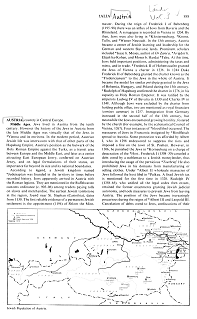
 Encyclopaedia
Judaica
1971: Austria, vol. 3, col. 887-888
Encyclopaedia
Judaica
1971: Austria, vol. 3, col. 887-888